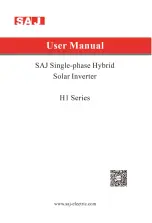
Step 4: Connecting the AC Input Wires
445-0089-01-01
3–11
Step 4: Connecting the AC Input Wires
General AC Wiring Considerations
AC Wiring
Connectors
Connect AC wires with twist-on wire nuts or crimp-on splice connectors
according to the type of installation:
•
On a boat, use crimp-on splice connectors to meet the American Boat and
Yacht Council’s Standards and Recommended Practices for Small Craft,
which do not allow twist-on connectors for AC connections.
•
For non-marine installations subject to vibration, you should still use crimp-
on connectors.
•
For non-marine installations in locations not subject to vibration, twist-on
wire nuts may be used instead of crimp-on connectors.
•
The amount of insulation you strip off individual wires will be specified by
the connector manufacturer and is different for different types of connectors.
AC and DC Wiring
Separation
Do not mix AC and DC wiring in the same conduit or panel. Where DC and AC
wires must cross, make sure they do so at 90
°
to one another. Consult code for
details about DC and AC wiring in vicinity to each other.
AC Wiring
Compartment
For your reference, the AC Wiring Compartment is shown in Figure 3-3.
WARNING: Fire, Shock and Energy hazards
Make sure wiring is disconnected from all electrical sources before handling. All wiring
must be done in accordance with local and national electrical wiring codes. Do not connect
the output terminals of the PROsine to any incoming AC source.
Figure 3-3
Interior of AC Wiring Compartment
Summary of Contents for PROsine 2.0
Page 1: ...PROsine 2 0 Inverter Charger User s Manual...
Page 2: ......
Page 3: ...PROsine 2 0 Inverter Charger User s Manual...
Page 8: ...vi...
Page 12: ...x...
Page 18: ...xvi...
Page 20: ...xviii...
Page 68: ...Installation 3 26 445 0089 01 01...
Page 120: ...Series Operation 7 12 445 0089 01 01...
Page 128: ...A 8...
Page 132: ...B 4...
Page 147: ......
















































